The Samsung SM932B Plus is a
slightly updated version of the standard SM932B model, now featuring Samsung's
Dynamic Contrast technology offering a 2000:1 (DC) ratio. Apart from
this, the specification, features and design remain the same. The model offers a
basic yet elegant appearance, with an impressive looking rounded bezel and stand, in a glossy
piano black finish. The model is available in both black and white versions, and
for this review Samsung have sent me the black version. Let's take a look at the
specs:
|
Size |
19" |
Colour Depth |
6-bit + FRC (16.2 million colours) |
|
Resolution |
1280 x 1024 |
Viewing Angles |
160 / 160 |
|
Response Time |
5ms |
Panel Technology |
TN Film |
|
Contrast Ratio |
700:1 (2000:1 dynamic) |
Interfaces |
DVI-D, VGA |
|
Brightness |
300 cd/m2 |
Colour |
Glossy Piano Black |
|
Special Features |
Tilt adjustment |
The specs are characteristically TN Film, with
nothing staggering to offer above other current 19" models. The response time
indicates a panel without RTC technology, we will test later whether this has
any influence on responsiveness in practice.
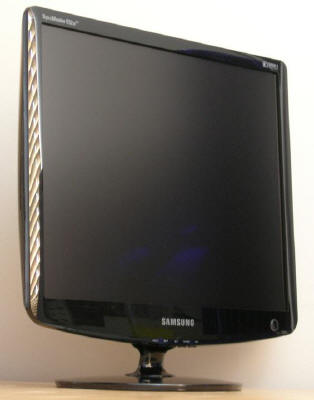
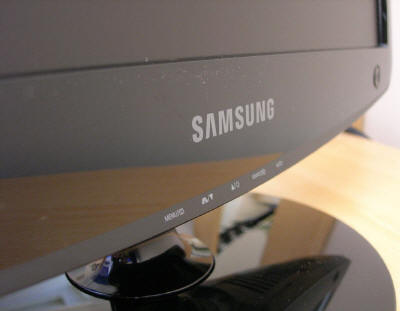
Above:
side view of the SM932B Plus and close up view of bottom of bezel
The SM932B Plus was actually a bit tricky to
photograph, since the bezel showed up some annoying reflections in the
pictures! The appearance of the monitor is sleak however, and the all black
finish is attractive. The materials are all of decent quality and feel sturdy.
While the bezel of the screen is glossy, the panel itself uses traditional
anti-reflective (AR) coating. The power LED glows a subtle blue colour in
operation which looks nice.
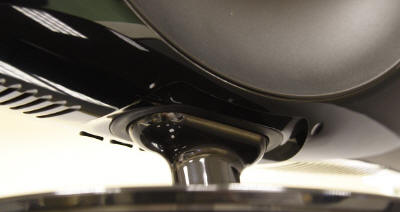
Above:
ball hinge attachment on bottom of monitor
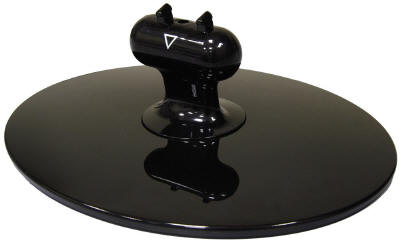
Above:
detached base showing ball hinge attachment
The ball hinge mechanism used to offer a tilt
function for this screen is smooth, but doesn't really afford much in the way of
adjustment, being only able to tilt back about 5-10° from vertical. You need to
exert a reasonable amount of force to attach the main section of the screen to
the base as well, which comes packaged seperately. The screen lacks any further
ergonomic adjustments such as height or rotation, which are handy on a screen
this size. The screen also sits quite low down and so the lack of a height
adjustment might be off-putting to some users. Furthermore, the ball hinge meant
that the screen felt a little flimsy at the joint, and so not as firm as other
stands.
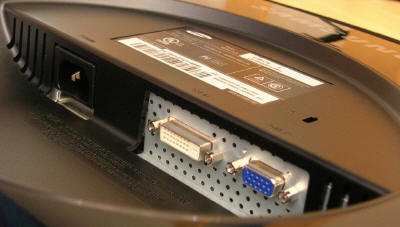
Above:
power connection and DVI-D / VGA interfaces
The back of the screen is rounded and looks
attractive, with the connections for VGA, DVI and power tucked out of the way.
There is unfortunately no cable tie available on this model, something quite
rare nowadays. The monitor
features an integrated power supply meaning you only need a kettle lead to power
the screen.
The OSD was intuitive to navigate, and the
operational buttons were easy to use and nicely tucked out of the way under the
bottom of the screen. You also have single click access to the MagicBright
presets, brightness, source (DVI vs VGA) and auto config options.
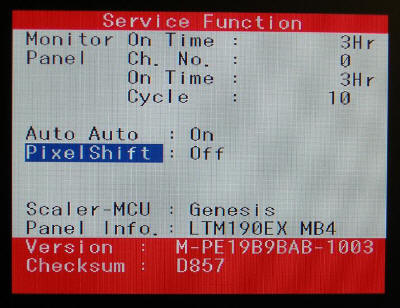
One trick for Samsung models is that you can often
access the factory menu in the OSD to access further information about your
screen. Most interesting to users is that it shows you which panel the screen is
using, a feature made famous during Samsung's recent
SM226BW 'panel lottery'.
For those who have Samsung screens, the factory menu can be accessed by doing
the following:
-
Set contrast and
brightness to 0
-
Press the « Menu » button
-
Press the « Source » button for
5 seconds
-
A hidden ''Service Function''
menu will appear including Panel Info on the bottom

Colour Quality and
Accuracy
The Samsung SM932B Plus utilises a 6-bit TN Film panel
with "Hi-FRC" (Frame Rate Control) technology,
capable of producing a reported 16.7 million colour palette. However, this is
not a true 8-bit colour depth. The standard CCFL
backlighting used offers a gamut covering 72% of the NTSC colour space, which
pretty much matches the sRGB colour gamut. An
important thing to consider for most users is how a screen will perform out of
the box and with some basic manual adjustments. Since most users won't have
access to hardware colorimeter tools, it is important to understand how the
screen is going to perform in terms of colour accuracy for the average user. I
restored my graphics card to default settings and set it to its standard
profile. The SM932B Plus was tested at default factory
settings out of the box using the
LaCie Blue Eye Pro and their accompanying software suite.
Default settings of the screen were 100 brightness, 80 contrast. Gamma Mode was
set to '1', MagicColor was turned 'off', MagicBright profiles was set at 'custom',
Color tone was set at 'normal' and RGB levels were all at the default level of
50.

Samsung SM932B Plus - Default Settings


|
|
Default Settings |
|
luminance (cd/m2) |
270 |
|
Black Point (cd/m2) |
0.27 |
|
Contrast Ratio |
1000:1 |
Testing the screen out of the
box with default settings gave some pleasing results. Before I even analysed the
screen with the colorimeter, you could tell the screen felt pretty good in terms
of contrast and colour levels. Brightness was a little high, with the default
OSD setting being 100. However, this was not as blinding and overbearing as some
other screens I have tested when they were set at 100% brightness and did not
serve to wash out the colours very badly. Colours felt good, and even to the eye you could tell they were a little more accurate than
the common, cartoony vivid shades you can get on some displays out of the box.
Testing the screen with the
LaCie colorimeter showed some good results as well. Luminance was clearly way out
from the target 120 cd/m2 desireable for LCD displays in normal
lighting conditions, being measured at 270 cd/m2. This was almost as
high as the specified 300 cd/m2. Black depth was recorded at a decent
enough 0.27 cd/m2 with a useable contrast ratio offered of 1000:1,
even above the specified 700:1 of the screen without its dynamic contrast
control. A very impressive result there for a TN Film panel. Gamma was some way
out at 1.9, compared with the 2.2 we aspire to for LCD displays in our tests. I
tested the screen using the other gamma preset modes which showed a gamma of 1.7
in mode 2, and of 2.1 in mode 3. If nothing else, you can at least change to use
gamma mode 3 with this screen to give you a slightly better result, if
calibration is not possible with hardware devices. Colour temperature was pretty
accurate at 6464k, only 1% out from the desired 6500k. As expected, the screen
pretty much covered the sRGB colour gamut, a result common of LCD displays with
standard CCFL backlighting.
The
graph on the right shows the DeltaE values for colours tested by the LaCie Blue
Eye Pro. As a reminder, the lower these bars down the Y-axis, the better, in
terms of colour accuracy. For reference, LaCie describe the DeltaE readings as:
-
If DeltaE >3, the color displayed is significantly different from the
theoretical one, meaning that the difference will be perceptible to the
viewer.
-
If DeltaE <2, LaCie considers the calibration a success; there remains a
slight difference, but it is barely undetectable.
-
If DeltaE < 1, the color fidelity is excellent.
Colour accuracy was also pretty impressive, with an average DeltaE of only 2.8.
Maximum DeltaE was only 5.9, and this shows Samsung have spent some time
calibrating this screen before it
leaves the factory. This is important for users to consider, since without
calibration tools, it's hard to get the best from your screen. With results like
this, users can feel comfortable that the SM932B Plus would at least offer them some
pretty decent colour accuracy, even without calibration. Again, a very good
result for a TN Film panel as well, which are typically quite poor at default
settings due to their low retail costs. This was certainly more impressive
than I saw with another Samsung model tested recently, the
SM931C, which is in fact aimed at colour enthusiasts! Admittedly, the 931C is
using a TN Film panel from CMO, whereas the SM932B Plus is using one of
Samsung's own panels (LTM190EX). Clearly the Samsung version offers much better
default colour accuracy than CMO's panel. Let's see if it can also offer bette
results with calibration:

Samsung SM932B Plus - Calibrated Results

|
|
Calibrated Settings |
|
luminance (cd/m2) |
119 |
|
Black Point (cd/m2) |
0.14 |
|
Contrast Ratio |
850:1 |
During the calibration process
brightness was adjusted to 40, contrast was adjusted to 70, and RGB levels were
adjusted to 58/50/50 respectively. After calibration, the Samsung SM932B Plus
was again impressive. Gamma, luminance and colour temperature were all pretty
much spot on now. Black depth was also improved greatly to a very impressive
0.14 cd/m2. This was better than the Samsung SM931C (0.21 cd/m2)
and Viewsonic VX2435WM (0.22 cd/m2) tested recently, and in fact was
the second best screen we have tested, coming close behind the Samsung 971P
(0.10 cd/m2). When you consider that the 971P is a PVA based screen,
renowned for deep blacks, and the SM932B Plus is 'only' TN Film, this is a very
decent result and goes to show the improvements that Samsung have made in their
latest generation of "Best TN III" panels. With this impressive 0.14 cd/m2
black depth, the screen was capable of offering a useable contrast ratio of
850:1, again above the listed 700:1 on their spec sheet.
Colour accuracy was also
improved nicely, with an average DeltaE now of only 0.9. LaCie would rate colour
fidelity as excellent overall with proper calibration. Maximum DeltaE was only
2.5 but overall this was a good result for a TN Film panel. This model is
perfectly adequate for most average users, even those who might need to do a bit
of colour / photo work at some point. Clearly there are even more superior
screens out there for real enthusiasts, but considering this is a low priced TN
Film model, it offers some very good colour accuracy at both factory and
calibrated settings. Testing the screen with colour gradients showed no obvious
banding problems, but some gradation in darker tones as is common with TN Film
panels. The FRC algorithms showed some slight twinkling, but only if you look
very hard, and not something which would bother you in normal use.

Viewing Angles
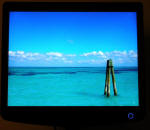
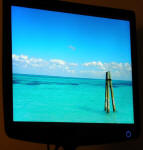




Above: (top) Viewing
angles shown from front and sides
(bottom) from above and from below. Click for larger images
The viewing angles of the
SM932B Plus were, perhaps unsurpisingly, quite restrictive. Being based on TN
Film technology, the vertical viewing angles were the worst, with an obvious
contrast shift as you move your field of view. To be honest, they weren't as bad
as some other TN Film panels I have tested, which have exhibited obvious shift
even with slight movement away from a central view. The SM932B Plus was actually
not too bad from above, and you had to go a little further than normal below
before you see the characteristic blackening of the image. Again, horizontally
the viewing angles weren't too bad, and while they are clearly behind other
technologies such as VA/IPS panels, they are better than some other screens I
have tested with TN Film panels. There was a shift to a noticeable yellow hue
from about 20° but only becoming very obvious from about 40°. Obviously viewing
angles are not the strong point of any TN Film based model, but not really a
problem here for an average user.

Panel Uniformity
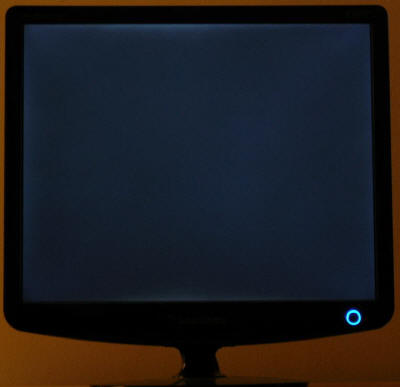
Click for larger
image
In our usual testing process I viewed an all black
screen in a darkened room, which allowed me to test the uniformity of the panel
and to examine whether any backlight bleed was evident. There was some slight
bleed detectable from the edges of the screen as the above image demonstrates.
This was particularly pronounced at the top and bottom which could prove a
little distracting for movie viewing where black borders are present. However,
while the picture perhaps exagerates this a little, the leakage was quite
minimal and not really a problem in normal use.

Office and Windows Use
The Samsung SM932B Plus is no
different from any other 19" screen really when it comes to office use. With
adjustment of the brightness setting you can achieve a comfortable level for
working with Office's white backgrounds. The 'text' MagicBright setting was
actually even a little darker than my calibrated 120 cd/m2 brightness
level, something which users might find handy when working at night or in low
light environments. The VGA connection offered a decent enough picture quality,
but was not quite as sharp as when using the DVI connection. If you want side by
side office working you'd need to consider a larger screen size / resolution,
but for most users the 932B Plus will be perfectly fine.

Responsiveness and Gaming



The Samsung SM932B Plus was tested using the chase
test in PixPerAn, a good bit of software for trying to quantify differences in
real terms responsiveness between monitors. As a reminder, a series of pictures
are taken on the highest shutter speed and compared. The images above show the
best case example on the left hand side, and the worst case example on the right
hand side. This should only be used as a rough guide to comparative
responsiveness but is handy as a way of keeping a constant test of each screen.
As you can tell from the above images, the SM932B
was pretty comparable to the Acer AL2216W and Viewsonic VX2245WM screens we have
tested in the past. Why did we compare with these models? They are all based on
5ms rated TN Film panels. All these models are the latest generation of TN Film
technology, offering a 5ms ISO response time without any additional Response
Time Compensation technology used. This means that across grey to grey
transitions, the panels remain slower than those utilising overdrive
technologies, and actual responsiveness in practice is therefore affected. You
can therefore see a more pronounced blur to the moving car in the testing, along
with a defined 'ghost' image, even to the naked eye.

In contrast, the overdriven 2ms
G2G rated SM931C offers the above results when tested with the RTA (overdrive)
function enabled. You can clearly see the improvements which RTC technologies
can offer, and not only is the response time improved on paper (2ms G2G is an
obvious indication that RTC is used), but it is also improved in practice.
As a result of this, and given
that the SM932B Plus is lacking any RTC, the screen is probably not as suited to
gaming as some other models in the market. The screen may well be adequate for
most average users, and certainly when you consider that many users have found
non-overdriven TN Film panels perfectly acceptable for some years, the SM932B
Plus should be fine for many prospective buyers. However, the improvements in
responsiveness that overdrive can offer are quite noticeable and so if you are a
more serious gamer then you may want to consider some of the modern screens with
response times quoted as less than 5ms (the current ISO limit), or where G2G
figures are used instead. The Samsung SM931C and LG L1960TQ are two such models
which we have tested at TFTCentral, but there are also many other well
established models such as the Viewsonic VX922 which are worth considering. I
found motion blur was noticeable in gaming, especially when you know what to
look for, but the screen still remained adequate for most average users in
practice I would say.
The 'Game' preset MagicBright
mode boosted brightness significantly (to 100% in fact) and also adjusted
the contrast setting to 88. This preset mode might well be handy in gaming,
since often it is better to boost the brightness to bring out details in darker
scenes. With the screen's decent black depth, this model is at least capable of
showing a good detail level in dark conditions, something which is often a
struggle for TN Film panels.
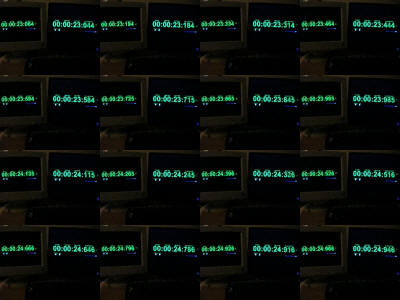
Above: Input lag tests with screen hooked up in clone mode with a CRT. Click for
larger image
As usual I tested the screen in clone mode with a
CRT to determine the level of input lag. This is something which can put off
some gamers and is a delay between graphics card and monitor output. By hooking
up a CRT you can show that the LCD lags behind somewhat, which can affect
users in some situations where they rely on the screen image being as fast as
their inputs (e.g. fast FPS shooting games). Often, input lag is very low and
probably wouldn't represent too much of a problem in real terms. The Samsung
SM932B Plus showed an average input lag of 15.6ms, which was not bad really
compared to other screens like the Acer AL2216W (typically 10ms) and
Viewsonic VX2245WM (10 - 20ms) for instance. Maybe an issue for some serious
gamers, but probably not to most normal users.

Movies and Video

I found it hard not to just
copy and paste what I recently wrote in the review of the
Samsung SM931C! If you want a screen for regular movie use you would be
better suited to a widescreen format monitor in my opinion, and preferably one
which is not TN Film based. The SM932B Plus was adequate for occasional viewing,
with restrictive viewing angles and limited ergonomic adjustments being the two
main concerns here. Black depth and colour accuracy were at good at least
offering some good performance even in darker scenes. The MagicBright preset for
movies boosted brightness quite a lot, which might be handy to some users.
Equally the dynamic contrast mode can be useful here, a feature which is really
suited to movie viewing and not much else. The DVI interface is not
HDCP certified on this model, which could cause potential issues in the
future when trying to watch encrypted content.
Responsiveness was sufficient
to eliminate ghosting in fast movie playback scenes, but a little blur was still
detectable. Noise and artefacts were not really a problem here, and as usual, if
you're a sensible distance away for viewing, you just aren't going to see any
problems.

Conclusion
I found the SM932B Plus to be a nice screen for
average use really, with a response time adequate for some gaming, and some
average specs and ergonomics which you would expect from a modern 19" model. The
design was attractive, but I couldn't help feel the screen lacked a few features
and adjustments that other models can offer. The SM932B Plus did well in our
colour accuracy testing though, showing good results even at default settings.
The contrast and black depth this screen can offer were very impressive, and so
if you want a budget 19" model, but with some decent performance for some
average photo work, this would make a good choice.
|
Pros |
Cons |
|
Decent colour accuracy, even
at default settings |
Limited ergonomic adjustments |
|
Excellent black depth and
contrast ratio |
Only average responsiveness
compared with other 19" models available today |
|
Attractive design |
|